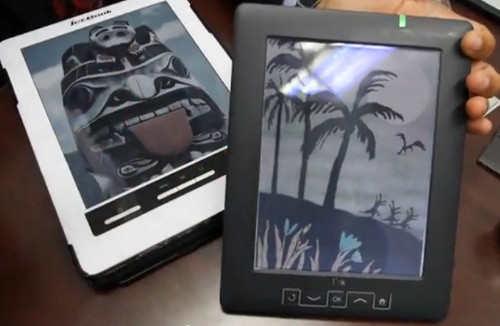E Ink was at CES last week and as usual they had some demo products to display. E Ink is best known for the screens that they supply for ebook readers. The vast majority of E Ink screens are monochrome, but they also make color screens as well. E Ink calls them Triton displays.
Color E Ink screens have been out for a few years now, but they have yet to take off. The main reason is because colors appear washed out and the screen color is too gray. The less ambient light there is the worse the screen looks.
E Ink has since released an updated version of color displays and are calling them Triton 2. We’ve seen them briefly in videos from past conferences, but this time we’ve got a more in-depth look.
It still remains to be seen if the new screens are going to be more successful than the last. A major hurdle with color E Ink is that color isn’t going to be nearly as bright as people are accustomed to with LCD screens, and then there’s the fact that resolution isn’t as good. It’s even noted toward the end of the video how text contrast isn’t as good on color screens as it is on current black-and-white E Ink screens.
At least two companies already have plans to release an ebook reader with a Triton 2 display. PocketBook has already announced plans to release a 9.7″ color ereader with a built-in frontlight. And Ectaco has an updated version of the JetBook Color, as shown in the video below, but it isn’t expected to have a frontlight.


A Nook or Kindle with front-light and Triton display? I’d buy one!
Problem is, you’d be one of only a few people to do so. Here’s the problem… the screen technology, while full color, is bulky and expensive. that’s why these are 9+ inch displays. While E-ink advertises a 1600×1200 display (technically, they’re correct), each “pixel” is actually made up of four pixels in a square; one black, and the three colors used to generate other colors. This effectively drops the resolution to 800×600. Couple that with the muddy colors (even on the Triton 2), the low refresh inherent to e-ink, and the ungodly cost ($500 USD for a dedicated ereader that does NOTHING else), and these devices are headed for doom. Their battery life doesn’t even come close to monochrome e-ink devices, either. For $200 less, I can get an iPad mini that does a WHOLE lot more.
The concept of the screen technology is good, but was implemented poorly.
Keep in mind these are exactly the same technology as monochrome e-ink screens, except they have a color filter on top. This is what leads to the washed-out color; less light is reflected because some is absorbed by the color filter. Even still, it’s roughly on par with newsprint. As far as power consumption goes, a Triton display with 800×600 color pixels will have 1600×1200 monochrome pixels beneath, and thus use no more power than a plain 1600×1200 monochrome display. Remember, the color filter is a completely passive element.
If they can improve the perceived brightness and color saturation, perhaps by having the filter layer recycle the blocked light in some manner (analogous to 3M’s ‘Vikuiti’ brightness-enhancing films for LCDs), I see these displays becoming quite popular.
One of the points is that text isn’t as sharp. This can be addressed through subpixel rendering, the same thing that makes text on your smartphone or computer LCD display appear as smooth as it does. When the pixels are small enough, the eye doesn’t tend to perceive the color of individual subpixels as much as it does their brightness.
Lastly, I’d have to agree more or less with Dave- if I had the chance (and the money), I’d snap one of these puppies up in a heartbeat, as long as it was a relatively ‘open’ device (this rules out the Kindle, for me). I remember hunting around in vain for the Hanvon color e-ink reader, finding the JetBook Color, and being so disappointed that the underlying Windows CE wasn’t accessible.
I think that the technology will eventually go places and head in the right direction. Look at the color LCD monitor when it first came to the consumer level laptops way back in the day. Those were garbage… and were regarded as such by the critics of the day. Someone had to do it and get development rolling on a consumer level.
Insofar as the ebook reader goes, I think that a 10-ish inch screen might be a bit large for most to swallow. I’d like to see a smaller Triton 2 screen with a possibly tighter pixel density.
Likelier than anything, though is that some blended technology of color e-ink, Mirasol, and electrowetting (very exciting technology, BTW) will hit the magic performance to price ratio. That’s a bit down the road, though. For right now, it’s just too expensive to be successful.
So much glare…
Recently, first E-Ink Triton 2 device was released!
It is called “Pocketbook Color Lux”, by Russian company.
There is already a video about it at Youtube! Check it 🙂
I am very excited by this device and its features.
It will be released at June 2013, price $319 for internal market,
and would be $349 with international shipping cost included
(if you have a friend in Russia and ask him to send to you)
There are other devices using Triton 2 screens too, like the Jetbook Color 2, but the Pocketbook is the first 8 inch model, plus it has a frontlight. Triton 2 is marginally better than the first gen, which isn’t saying much; hopefully the frontlight helps a lot.